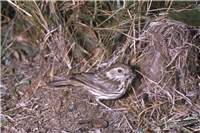Family
Pardalotidae
Genus
Chthonicola
Species
sagettata
Threats/Control Methods - Regional
Only 3-4% of its local habitat, the Yellow Box/Red Gum Grassy Woodland remains in something like its natural state, putting a further strain on the population. This is due to land clearing for urban development or agriculture and the removal of fallen timber and leaf litter. Increased grazing from Eastern Grey Kangaroos (Marcropus giganteus) or stock animals are also leading to grassy habitat destruction. Due to the unprotected nature of their nests, Speckled Warblers are especially prone to predation from European Red Foxes (Vulpes vulpes), Dogs (Canis familiaris) and Cats (Felis catus). Within NSW, fox and feral cat programs are being undertaken.
Threats/Control Methods - Local
The invasion into the suburban nature reserves by introduced weeds and predation by feral and uncontrolled domestic animals, or by more aggressive birds such as Pied Currawongs (Strepera graculina ) or Noisy Minors (Manorina melanocephala ) are major local threats.
Local/Urban Actions
The preservation of large areas of suitable woodland habitat is key to the survival of this species. Greening Australia holds revegetation events, as do local Landcare groups. Cat owners can prevent their pets preying on the species by providing a stimulating indoor environment and by installing a cat run or enclosure. Collecting firewood from nature reserves or national parks should not be undertaken, as this will impact on the important foraging and nesting resources. Gardeners can reduce the likelihood of weed species spreading by ensuring their gardens are free from recognised problem plants.
Common Names
Speckled Warbler, Blood Tit, Chocolate Bird
Distinguishing Features
This small bird of 12-13cm has a very streaked appearance. The bird's head, back, wings and tails are a grey-brown colour, with some white or black streaks. The face below the brow and the underparts are an off-white colour with dark streaks and a yellow tint. The male has a black streak for a brow, while the female's brow is rusty-red.
Survey Techniques
Call and visual identification.
Species Call
Musical, cheery song of sharp whistles to mellow notes or mimicry of other birds.
Similar Species
The very similarly sized and speckled Little Grassbird (Megalurus gramineus ) has less of a yellow tint and has a longer tail and bill.
Distribution
This species is mostly found in the mountainous areas of NSW, southern QLD and VIC.
Country of Origin
Australia
Conservation (Pet/Pest) Status - Regional
This species is rarely seen in the Canberra region, sometimes spotted in the fringing suburbs near nature reserves (COG). Recognised as a declining woodland bird by Greening Australia ACT and SE NSW region.
Conservation (Pet/Pest) Status - National
Secure, not listed under the EPBC Act 1999. However, in NSW the species is considered Vulnerable, as there has been a marked decline in population numbers across their range.
LSCCES Population
A few birds were seen in the undeveloped areas of BMt and during the coldest months, a few were spotted down slope in Turner.
Associated vegetation community
The Speckled Warbler prefers open, rocky grassland country and eucalypt woodland with gullies and sparse, shrubby vegetation.
Limiting Resources
This species depends upon an environment of complex vegetation, with thick, grassy ground cover, leaf litter, logs, shrubs and trees. It will not survive if its habitat is continuously fragmented due to land clearing. Areas free from predation from domestic and feral animals are also neccesary.
Breeding
The breeding season for the Speckled Warbler runs from August to January. The nests are an untidy dome with a side entrance, built of grass and shredded bark. It sits on the ground amongst grass tussocks, low shrubs and fallen logs. A breeding territory is about 10ha. A pair share nesting responsibilities and care for 3-4 eggs that are a distinctive glossy red-brown colour. Its nest is prone to predation and nest failure rates are as high as 80% in some areas.
Behaviour
This bird is usually seen in pairs or small groups foraging through leaf litter, often with Buff-rumped Thornbills (Acanthiza reguloides ).
Functional Group
Food Species
This species eats a range of insects, other small invertebrates and some seeds.
Predators
These ground dwelling birds are susceptible to a range of predators, including feral or domestic European Red Foxes (Vulpes vulpes), Dogs (Canis familiaris), Cats (Felis catus) and other larger bird species.
Interesting Fact
The Speckled Warbler gained the nicknames 'Blood Tit' and 'Chocolate Bird' because of their glossy red-brown eggs.


 Top
Top Top
Top